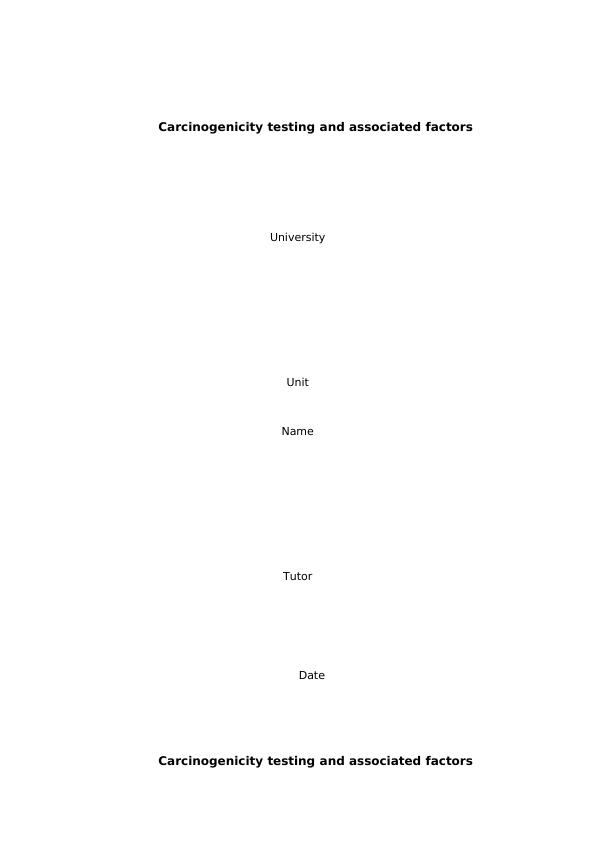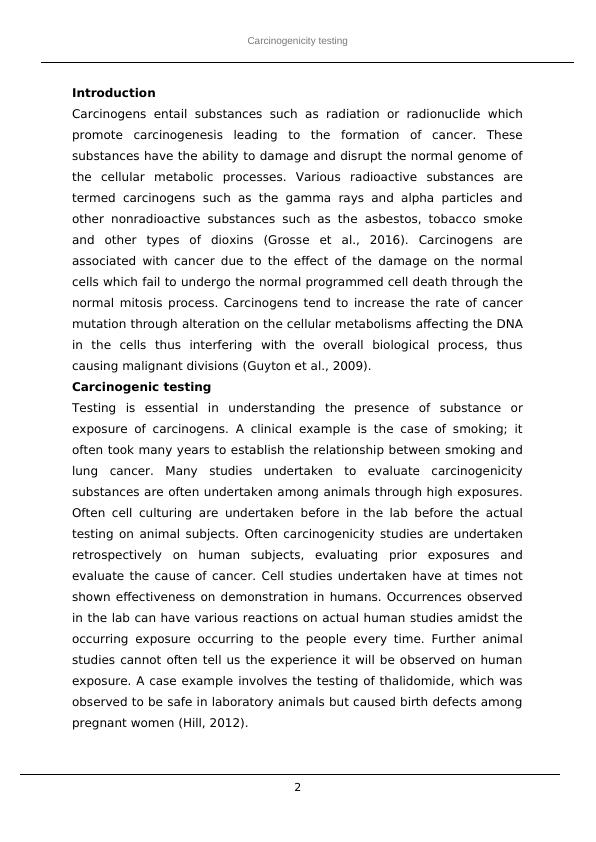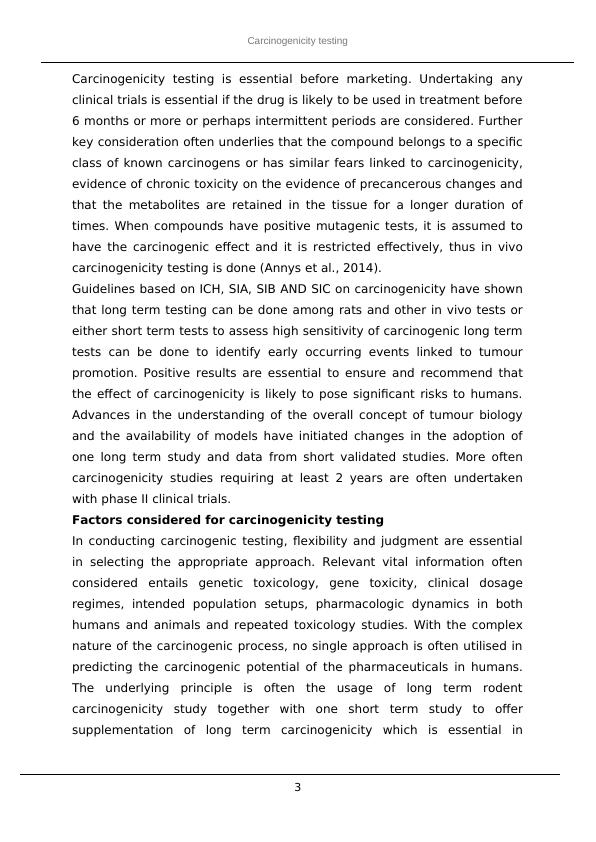Carcinogenicity Testing and Associated Factors
Added on 2023-01-20
6 Pages1616 Words56 Views
Carcinogenicity testing and associated factors
University
Unit
Name
Tutor
Date
Carcinogenicity testing and associated factors
University
Unit
Name
Tutor
Date
Carcinogenicity testing and associated factors

Carcinogenicity testing
Introduction
Carcinogens entail substances such as radiation or radionuclide which
promote carcinogenesis leading to the formation of cancer. These
substances have the ability to damage and disrupt the normal genome of
the cellular metabolic processes. Various radioactive substances are
termed carcinogens such as the gamma rays and alpha particles and
other nonradioactive substances such as the asbestos, tobacco smoke
and other types of dioxins (Grosse et al., 2016). Carcinogens are
associated with cancer due to the effect of the damage on the normal
cells which fail to undergo the normal programmed cell death through the
normal mitosis process. Carcinogens tend to increase the rate of cancer
mutation through alteration on the cellular metabolisms affecting the DNA
in the cells thus interfering with the overall biological process, thus
causing malignant divisions (Guyton et al., 2009).
Carcinogenic testing
Testing is essential in understanding the presence of substance or
exposure of carcinogens. A clinical example is the case of smoking; it
often took many years to establish the relationship between smoking and
lung cancer. Many studies undertaken to evaluate carcinogenicity
substances are often undertaken among animals through high exposures.
Often cell culturing are undertaken before in the lab before the actual
testing on animal subjects. Often carcinogenicity studies are undertaken
retrospectively on human subjects, evaluating prior exposures and
evaluate the cause of cancer. Cell studies undertaken have at times not
shown effectiveness on demonstration in humans. Occurrences observed
in the lab can have various reactions on actual human studies amidst the
occurring exposure occurring to the people every time. Further animal
studies cannot often tell us the experience it will be observed on human
exposure. A case example involves the testing of thalidomide, which was
observed to be safe in laboratory animals but caused birth defects among
pregnant women (Hill, 2012).
2
Introduction
Carcinogens entail substances such as radiation or radionuclide which
promote carcinogenesis leading to the formation of cancer. These
substances have the ability to damage and disrupt the normal genome of
the cellular metabolic processes. Various radioactive substances are
termed carcinogens such as the gamma rays and alpha particles and
other nonradioactive substances such as the asbestos, tobacco smoke
and other types of dioxins (Grosse et al., 2016). Carcinogens are
associated with cancer due to the effect of the damage on the normal
cells which fail to undergo the normal programmed cell death through the
normal mitosis process. Carcinogens tend to increase the rate of cancer
mutation through alteration on the cellular metabolisms affecting the DNA
in the cells thus interfering with the overall biological process, thus
causing malignant divisions (Guyton et al., 2009).
Carcinogenic testing
Testing is essential in understanding the presence of substance or
exposure of carcinogens. A clinical example is the case of smoking; it
often took many years to establish the relationship between smoking and
lung cancer. Many studies undertaken to evaluate carcinogenicity
substances are often undertaken among animals through high exposures.
Often cell culturing are undertaken before in the lab before the actual
testing on animal subjects. Often carcinogenicity studies are undertaken
retrospectively on human subjects, evaluating prior exposures and
evaluate the cause of cancer. Cell studies undertaken have at times not
shown effectiveness on demonstration in humans. Occurrences observed
in the lab can have various reactions on actual human studies amidst the
occurring exposure occurring to the people every time. Further animal
studies cannot often tell us the experience it will be observed on human
exposure. A case example involves the testing of thalidomide, which was
observed to be safe in laboratory animals but caused birth defects among
pregnant women (Hill, 2012).
2

Carcinogenicity testing
Carcinogenicity testing is essential before marketing. Undertaking any
clinical trials is essential if the drug is likely to be used in treatment before
6 months or more or perhaps intermittent periods are considered. Further
key consideration often underlies that the compound belongs to a specific
class of known carcinogens or has similar fears linked to carcinogenicity,
evidence of chronic toxicity on the evidence of precancerous changes and
that the metabolites are retained in the tissue for a longer duration of
times. When compounds have positive mutagenic tests, it is assumed to
have the carcinogenic effect and it is restricted effectively, thus in vivo
carcinogenicity testing is done (Annys et al., 2014).
Guidelines based on ICH, SIA, SIB AND SIC on carcinogenicity have shown
that long term testing can be done among rats and other in vivo tests or
either short term tests to assess high sensitivity of carcinogenic long term
tests can be done to identify early occurring events linked to tumour
promotion. Positive results are essential to ensure and recommend that
the effect of carcinogenicity is likely to pose significant risks to humans.
Advances in the understanding of the overall concept of tumour biology
and the availability of models have initiated changes in the adoption of
one long term study and data from short validated studies. More often
carcinogenicity studies requiring at least 2 years are often undertaken
with phase II clinical trials.
Factors considered for carcinogenicity testing
In conducting carcinogenic testing, flexibility and judgment are essential
in selecting the appropriate approach. Relevant vital information often
considered entails genetic toxicology, gene toxicity, clinical dosage
regimes, intended population setups, pharmacologic dynamics in both
humans and animals and repeated toxicology studies. With the complex
nature of the carcinogenic process, no single approach is often utilised in
predicting the carcinogenic potential of the pharmaceuticals in humans.
The underlying principle is often the usage of long term rodent
carcinogenicity study together with one short term study to offer
supplementation of long term carcinogenicity which is essential in
3
Carcinogenicity testing is essential before marketing. Undertaking any
clinical trials is essential if the drug is likely to be used in treatment before
6 months or more or perhaps intermittent periods are considered. Further
key consideration often underlies that the compound belongs to a specific
class of known carcinogens or has similar fears linked to carcinogenicity,
evidence of chronic toxicity on the evidence of precancerous changes and
that the metabolites are retained in the tissue for a longer duration of
times. When compounds have positive mutagenic tests, it is assumed to
have the carcinogenic effect and it is restricted effectively, thus in vivo
carcinogenicity testing is done (Annys et al., 2014).
Guidelines based on ICH, SIA, SIB AND SIC on carcinogenicity have shown
that long term testing can be done among rats and other in vivo tests or
either short term tests to assess high sensitivity of carcinogenic long term
tests can be done to identify early occurring events linked to tumour
promotion. Positive results are essential to ensure and recommend that
the effect of carcinogenicity is likely to pose significant risks to humans.
Advances in the understanding of the overall concept of tumour biology
and the availability of models have initiated changes in the adoption of
one long term study and data from short validated studies. More often
carcinogenicity studies requiring at least 2 years are often undertaken
with phase II clinical trials.
Factors considered for carcinogenicity testing
In conducting carcinogenic testing, flexibility and judgment are essential
in selecting the appropriate approach. Relevant vital information often
considered entails genetic toxicology, gene toxicity, clinical dosage
regimes, intended population setups, pharmacologic dynamics in both
humans and animals and repeated toxicology studies. With the complex
nature of the carcinogenic process, no single approach is often utilised in
predicting the carcinogenic potential of the pharmaceuticals in humans.
The underlying principle is often the usage of long term rodent
carcinogenicity study together with one short term study to offer
supplementation of long term carcinogenicity which is essential in
3

End of preview
Want to access all the pages? Upload your documents or become a member.
Related Documents
Questions and Answers on Pharmacologylg...
|14
|3996
|326
Lung Cancer: Pathophysiology, Treatment with Cisplatin, and Adverse Effectslg...
|9
|1243
|44
THE END POINT DETERMINATIONlg...
|5
|1108
|16
Beneficial Anti-Oxidant Effect of Indole-3-Carbinollg...
|27
|9155
|72
CELL CULTURE AND NEUROTOXICITYlg...
|5
|1032
|21
Medical Geology Hazard: Impact of Geohazards on Human Healthlg...
|10
|2013
|24
